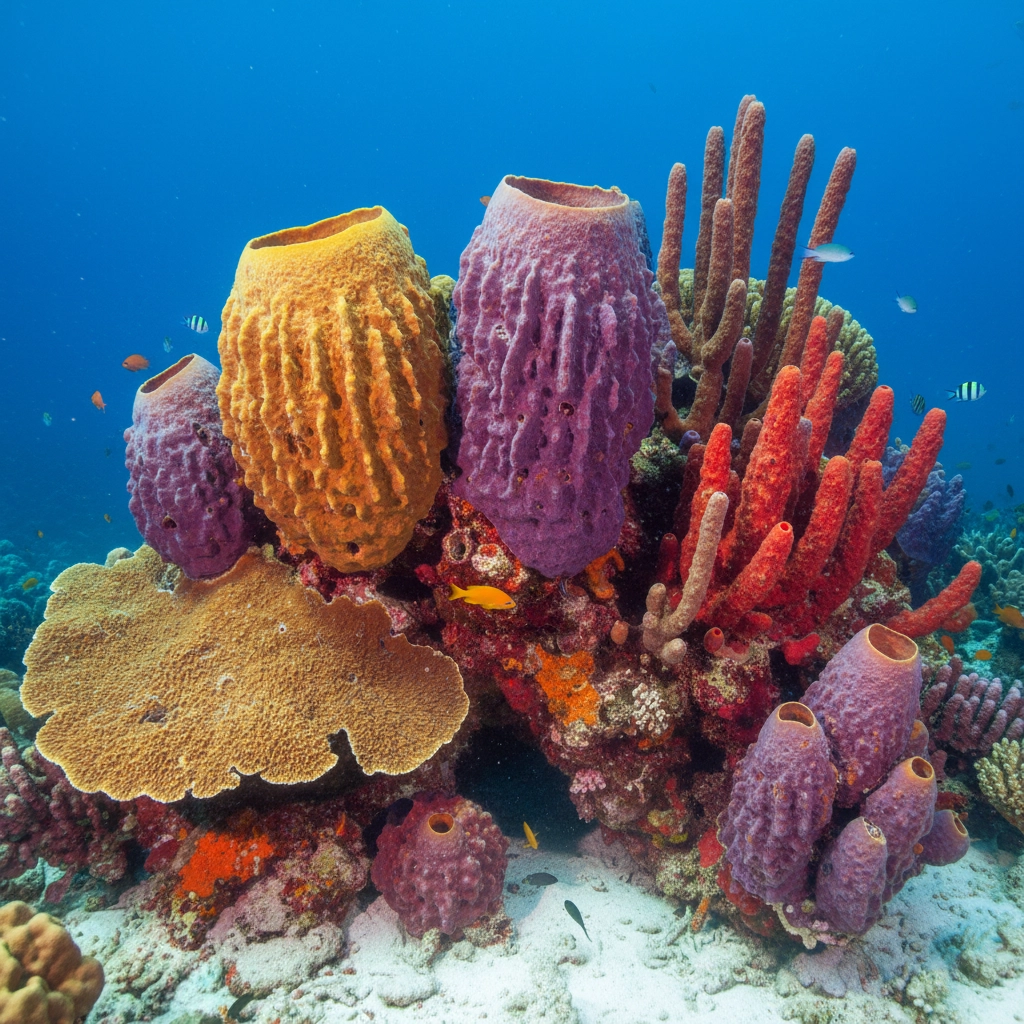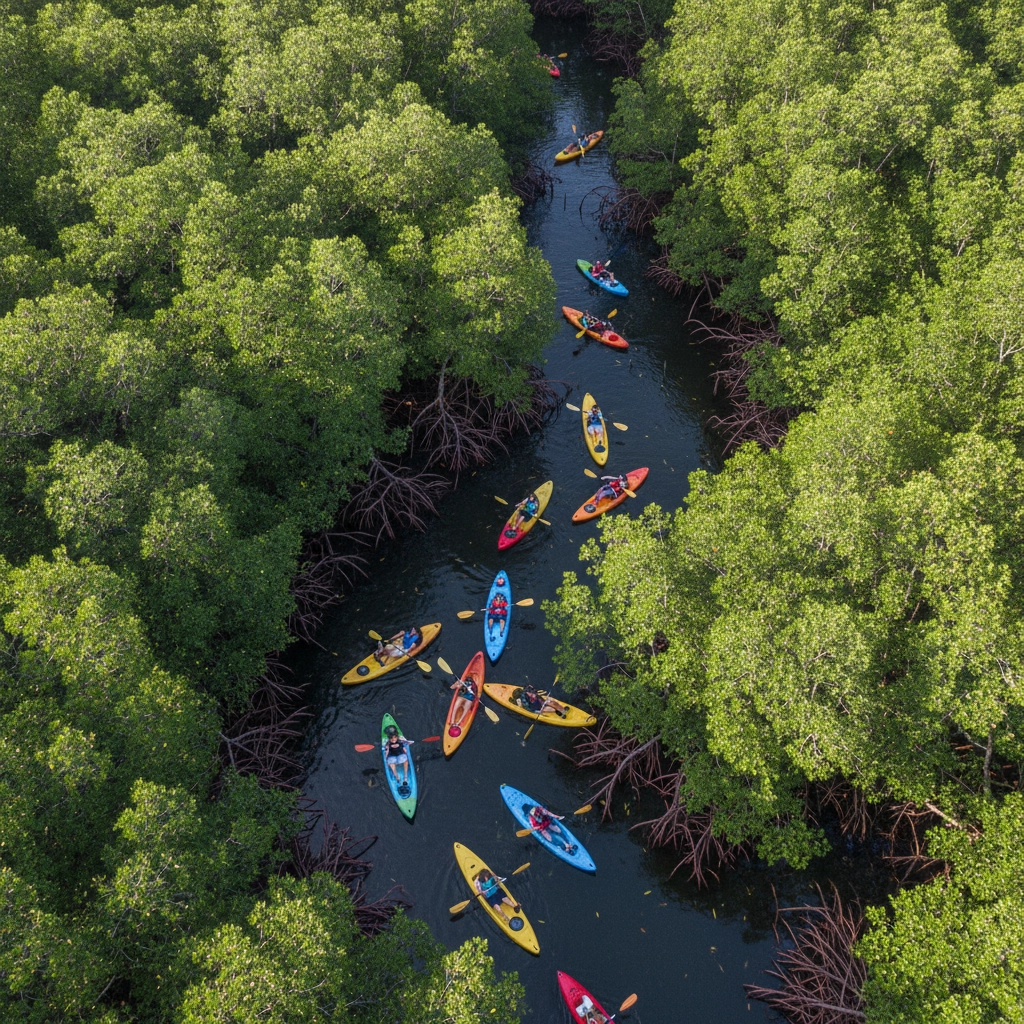Coral Reefs, Seagrass, and Mangroves: A Connected Ecosystem for Students to Explore
- Caleb Mullenix
- Oct 27
- 6 min read
Understanding the intricate connections between marine ecosystems is fundamental to comprehensive environmental education. The Florida Keys present an exceptional living laboratory where coral reefs, seagrass beds, and mangrove forests demonstrate one of nature's most remarkable interconnected systems. These three coastal ecosystems work in harmony, supporting one another while creating conditions necessary for thousands of species to thrive.
For educators seeking to provide students with transformative scientific experiences, the Florida Keys offer unparalleled opportunities to observe, study, and participate in active conservation of these interconnected habitats. Establishing clear learning objectives that emphasize ecosystem relationships will maximize your students' understanding of marine science principles while fostering environmental stewardship.
The Three Pillars of Florida Keys Marine Ecosystems
Coral Reefs: Underwater Cities of Biodiversity
Coral reefs function as the rainforests of the sea, built over millennia by coral polyps that create complex structures supporting extraordinary biodiversity. In the Florida Keys, the living coral reef tract extends over 200 miles, representing the only living coral barrier reef system in the continental United States. These vibrant ecosystems provide shelter, breeding grounds, and hunting territories for countless marine species ranging from microscopic plankton to large predators.
Students will observe how coral reefs require specific conditions to survive: clear, warm water with minimal sedimentation and pollution. Emphasize to your students that coral reefs are incredibly sensitive to environmental changes, making them excellent indicators of ocean health. Temperature fluctuations of just a few degrees can cause coral bleaching, demonstrating the delicate balance these organisms maintain.

Seagrass Beds: The Hidden Marine Prairies
Seagrass meadows represent some of the most productive ecosystems on Earth, often overlooked despite their critical ecological importance. These underwater prairies consist of flowering marine plants that stabilize sediments, improve water quality through nutrient filtration, and provide essential habitat for juvenile marine life.
Direct your students' attention to the remarkable productivity of seagrass beds. These ecosystems support an estimated 40,000 fish and 50 million invertebrates per acre. Students will discover that seagrass beds serve as nurseries for many species that will eventually inhabit coral reefs as adults, including parrotfish, snappers, and groupers.
The shallow nature of seagrass beds makes them ideal for kayaking expeditions where students can safely observe this ecosystem up close. Encourage students to note the clarity of water in healthy seagrass areas, as these plants filter sediments and excess nutrients that could otherwise harm coral reefs.
Mangrove Forests: Coastal Guardians and Nurseries
Mangrove forests represent unique transitional ecosystems where land meets sea. These remarkable trees have adapted to survive in saltwater conditions, developing specialized root systems that filter pollutants, prevent erosion, and create protective nursery habitats for countless species.
Students should understand that mangroves provide critical ecosystem services: they protect shorelines from storm surges, trap sediments that could smother coral reefs, and serve as nurseries for up to 80% of commercial fish species in South Florida. The tangled root systems create complex three-dimensional habitats supporting everything from microscopic organisms to large wading birds.
Prepare students to observe the remarkable adaptations mangroves have developed, including specialized roots that filter salt, aerial roots that provide oxygen, and propagules that can survive floating in saltwater for months before establishing new populations.
Wildlife Connections: Following the Marine Highway
Sea Turtles: Ecosystem Navigators
Sea turtles exemplify the interconnected nature of Florida Keys marine ecosystems. Green sea turtles graze extensively in seagrass beds, maintaining healthy grass blade length through their feeding behavior. Loggerhead and hawksbill turtles frequent coral reefs, with hawksbills specializing in sponge consumption while loggerheads hunt for crabs and other invertebrates.
Students will learn that sea turtles nest on beaches adjacent to mangrove systems, and hatchlings often seek shelter in floating sargassum before transitioning to reef environments as they mature. Emphasize to students that sea turtle conservation requires protecting entire ecosystem networks rather than isolated habitats.

Sharks: Apex Predators Maintaining Balance
Sharks play crucial roles in maintaining ecosystem health across all three habitats. Nurse sharks commonly rest in mangrove creeks during daylight hours before moving to seagrass beds and coral reefs to hunt at night. Reef sharks patrol coral formations, while bonnethead sharks specialize in hunting crustaceans in seagrass meadows.
Educate students about the critical importance of shark populations in maintaining ecosystem balance. Sharks control populations of herbivorous fish that graze on seagrass, preventing overgrazing while ensuring adequate pruning for healthy grass growth.
Field Study Opportunities in the Florida Keys
Kayaking Through Mangrove Tunnels
Organize kayaking expeditions through mangrove creeks to provide students with intimate access to this ecosystem. Ensure all students understand proper kayaking techniques and safety protocols before entering the water. Mangrove tunnels offer protected waters ideal for beginning paddlers while providing exceptional wildlife viewing opportunities.
Direct students to observe water clarity differences between open ocean areas and mangrove-protected zones. Students should document species diversity, noting how different organisms utilize various levels of the mangrove forest from the canopy to the root zone underwater.
Shallow Bay Habitat Studies
Conduct snorkeling expeditions in shallow bay areas where students can study sponge communities, seagrass ecosystems, and the transition zones between different habitats. Emphasize proper snorkeling safety procedures and environmental ethics, ensuring students understand they are observers rather than collectors.
Students should document sponge diversity and understand how these filter-feeding organisms contribute to water quality. Florida Bay contains over 70 sponge species, making it an ideal location for comparative studies of filter-feeding strategies and habitat preferences.

Coral Reef Monitoring and Assessment
Engage students in citizen science projects involving coral reef health assessments. Train students to identify common coral species, recognize signs of bleaching or disease, and document fish populations using standardized survey techniques.
Establish clear protocols for underwater observation, emphasizing the critical importance of maintaining appropriate distances from marine life and avoiding any physical contact with coral formations. Students should understand that even gentle contact can damage coral polyps and disrupt ecosystem function.
Interactive Learning Activities and Research Projects
Water Quality Testing Across Ecosystems
Implement comprehensive water quality testing programs that allow students to compare conditions across mangrove, seagrass, and coral reef environments. Students should measure temperature, salinity, dissolved oxygen, turbidity, and nutrient levels to understand how each ecosystem influences water chemistry.
Encourage students to develop hypotheses about expected differences between ecosystems and design experiments to test their predictions. This approach reinforces scientific methodology while demonstrating the quantifiable connections between habitats.
Species Migration and Life Cycle Tracking
Develop research projects focused on species that utilize multiple habitats throughout their life cycles. Students can study juvenile fish populations in mangrove nurseries, track their movement to seagrass feeding areas, and observe adult populations on coral reefs.
Create detailed life cycle charts that illustrate how individual species depend on ecosystem connectivity. Students should understand that habitat destruction in any single ecosystem can collapse entire species populations, even if other habitats remain intact.

Conservation and Service Learning Opportunities
Wild Bird Sanctuary Volunteer Programs
Arrange volunteer opportunities at local wild bird rehabilitation centers where students can participate in bird care, habitat restoration, and educational outreach programs. Many seabirds depend on healthy marine ecosystems for feeding and nesting, providing direct connections to ecosystem health studies.
Students should understand how bird populations serve as indicators of ecosystem health. Changes in bird abundance, breeding success, or physical condition often reflect broader environmental changes affecting entire ecosystem networks.
Community Engagement and Cultural Understanding
Develop service learning opportunities that allow students to work with local communities, including mentoring programs for children of migrant workers whose families depend on healthy marine ecosystems for their livelihoods. These programs provide cultural context for conservation efforts while demonstrating the human dimensions of environmental protection.
Emphasize to students that effective conservation requires understanding and supporting local communities who depend on marine resources. Students should learn about sustainable fishing practices, ecotourism benefits, and the economic importance of healthy ecosystems to local communities.
Educational Outcomes and Assessment Strategies
Comprehensive Ecosystem Understanding
Ensure students can articulate specific connections between coral reefs, seagrass beds, and mangrove forests. Students should demonstrate understanding of nutrient cycling, energy flow, and species migration patterns that link these ecosystems.
Develop assessment strategies that require students to predict consequences of habitat destruction in one ecosystem on the health and function of connected systems. This approach reinforces systems thinking while emphasizing the importance of comprehensive conservation strategies.
Scientific Communication Skills
Require students to present their findings through multiple formats including scientific reports, visual presentations, and community education materials. Students should demonstrate ability to communicate complex ecological concepts to diverse audiences using appropriate scientific terminology and clear explanations.

The interconnected nature of coral reefs, seagrass beds, and mangrove forests provides exceptional opportunities for comprehensive environmental education. Through carefully planned field studies in the Florida Keys, students gain firsthand understanding of ecosystem connections while developing scientific skills and environmental stewardship values. Successful educational programs emphasize hands-on observation, scientific methodology, and community engagement, ensuring students understand both the scientific principles governing these ecosystems and their responsibility as future environmental stewards.
Visit Appleseed Expeditions' South Florida programs to begin planning transformative educational experiences that will inspire your students' lifelong commitment to marine conservation and scientific understanding.



Comments